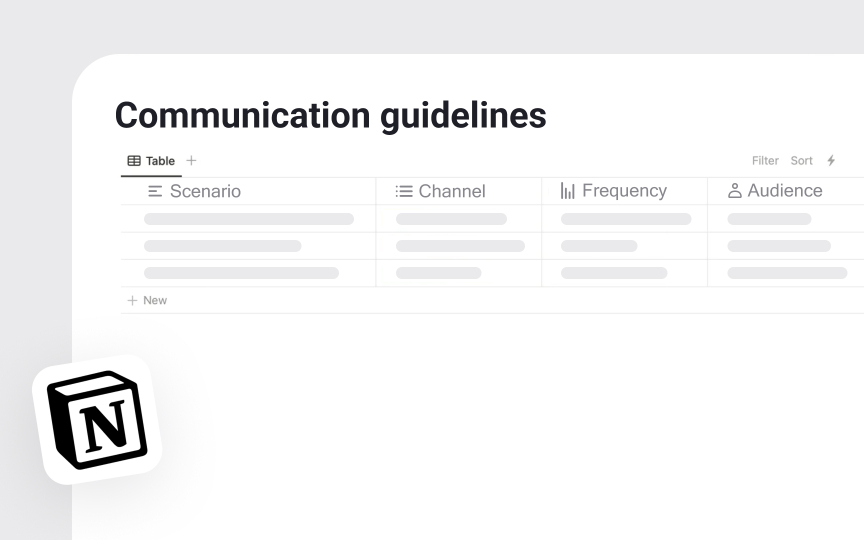Cross-Functional Collaboration
Explore ways to build bridges between teams to ship products that users love
Product managers work with engineers, designers, marketers, sales teams, customer support, legal and compliance, and customer success, and executives to bring products from concept to reality. Each team brings unique expertise to the table. Strong collaboration requires understanding each team's priorities, constraints, and success metrics. PMs must translate between technical jargon and business objectives, align competing priorities, and create shared goals that everyone can rally behind.
The best product managers build bridges between departments, facilitate productive discussions, and know when to push for consensus versus when to make decisive calls. They establish clear communication channels, run effective meetings, and create documentation that speaks to different audiences. Success in cross-functional collaboration means moving beyond just coordinating tasks to building genuine partnerships where every team feels heard, valued, and invested in the product's success.
Every team views products through their unique lens:
- Engineers assess technical feasibility and different ways to solve the problem in hand, system performance, and implementation complexity. They worry about scalability, maintenance costs, and whether features align with existing architecture.
- Designers champion user needs, visual consistency, and interaction patterns. They balance business goals with user experience, fighting for simplicity while others push for more features.
- Marketing teams focus on positioning, competitive advantages, and customer messaging.
- Sales wants features that close deals,
customer support needs bug fixes that reduce tickets, finance tracks revenue impact, customer success wants to improve their strategic clients' success rates, and legal wants the product and how we build it to comply with regulations.
Recognizing these perspectives helps product managers navigate trade-offs and build consensus around shared goals.
Trust forms the foundation of effective collaboration:
- Start by delivering on small commitments consistently. When you promise engineers user stories by Friday, deliver it.
- Listen actively during team discussions. Ask clarifying questions instead of making assumptions. Acknowledge when you don't understand something technical or need help interpreting user research.
- Share credit generously and take responsibility for mistakes. When launches succeed, highlight each team's contributions. When things go wrong, focus on solutions rather than blame.[1]
- Share updates before people need to ask. For example, let
marketing know early about timeline shifts or feature priorities that affect launch plans. - Show that you understand their goals. Learn what success means for each team, like
revenue for sales, adoption for marketing, retention for support, and explain product decisions in those terms. - Be transparent about trade-offs. If a decision benefits one area but limits another, explain why.
- Follow through on commitments. When you promise data for a leadership review or insights for a customer success deck, deliver on time.
Different teams prefer different communication styles:
- Engineers often favor asynchronous updates through
documentation and tickets - Designers might prefer visual collaboration in tools like Figma
- Sales teams typically want quick instant messages or brief calls
Establish clear protocols for various scenarios. Daily standups work for sprint teams but overwhelm stakeholders who need weekly summaries. Critical bugs require immediate message alerts, while feature requests belong in structured planning sessions. Document these agreements to prevent communication breakdowns.
Create templates for common updates: sprint summaries for executives,
Effective planning sessions require careful preparation. Send agendas before the meeting with clear objectives, required pre-reads, and expected outcomes. Alternatively, you can carve time in the meeting for everyone to read what they need to read together. Also, include time estimates for each topic and assign discussion leaders. This helps participants arrive prepared and engaged.
Design sessions for active participation, not passive listening. Define and share rules of engagement upfront, such as "no ideas are bad ideas" or "build on each other's thoughts," and prepare proper facilitation to ensure all voices are heard and everyone feels safe sharing opinions. Use techniques like silent brainstorming where everyone writes ideas before discussing, or breakout groups for complex problems.[3] Visual aids like journey maps or priority matrices keep discussions focused and inclusive.
End every session with clear next steps, owners, and deadlines. Send summary notes within 24 hours highlighting decisions made, open questions, and action items. Follow up on commitments before the next session to maintain momentum and accountability.
Pro Tip: Rotate meeting facilitation among team members to increase engagement and develop leadership skills.
Conflicts arise when teams have competing priorities. Engineering wants to refactor code while sales drives for new features. The product team pushes for research while executives demand faster shipping.
Address conflicts by first understanding root causes. Schedule separate conversations with each party to hear concerns without judgment. Often, conflicts stem from misaligned goals or incomplete information rather than fundamental disagreements. Clarify the shared objective before debating solutions.
Focus discussions on customer impact and business value rather than personal preferences. Use data to evaluate options objectively. When consensus proves impossible, make clear decisions and explain the reasoning. Teams respect transparent decision-making even when they disagree with decisions.
Clear decision-making frameworks prevent endless debates. Define decision types upfront: reversible decisions can move fast with individual owners, while irreversible choices need careful group consideration.
Document who makes which decisions. PMs own value (does it matter to users?) and viability (does it work for the business?). Engineering leads own feasibility (can we build it?). Design leads own usability (can users successfully use it?). But major pivots require executive input. This clarity reduces escalations and empowers teams to move quickly within boundaries.
For group decisions, try structured approaches. List options with pros and cons. Score against agreed criteria. When consensus or consent fails, designate a tiebreaker who makes final calls after hearing all perspectives.



















